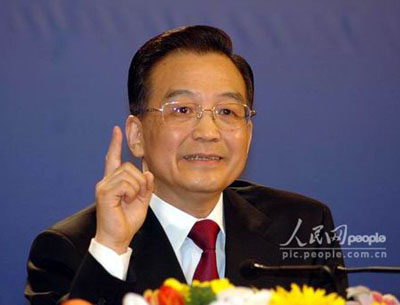
Fellow Deputies,
On behalf of the State Council, I would like to present to you the following report on the work of the government for your deliberation and approval. I also welcome comments and suggestions on my report from the members of the National Committee of the Chinese People's Political Consultative Conference.
I. Review of the Work of the Past Year
Major achievements were made in 2005 in the socialist modernization drive.
Economic growth was fast yet steady. China's GDP reached 18.23 trillion yuan in 2005, an increase of 9.9 percent over the previous year. Government revenue exceeded 3 trillion yuan, 523.2 billion more than the previous year. The consumer price index rose by 1.8 percent. China's economy was in good shape and characterized by fast growth, improved economic returns and stable prices.
Major steps were taken in reform and opening up. Breakthroughs were achieved in some key areas. China's import and export volume totaled US$1.42 trillion, an increase of 23.2 percent. Total foreign direct investment actually used reached US$60.3 billion, and the country's foreign exchange reserves totaled US$818.9 billion at the end of 2005.
Continued progress was made in social programs. Science and technology, education, culture, health, sports and other undertakings developed in an all-round way. The success of the Shenzhou VI manned spaceflight shows that China has reached world-class levels in some key areas of science and technology.
People's lives continued to improve. A total of 9.7 million urban residents entered the workforce for the first time last year. Urban per capita disposable income rose to 10,493 yuan, an increase of 9.6 percent after adjusting for inflation, and rural per capita net income grew to 3,255 yuan, an increase of 6.2 percent after adjusting for inflation.
China took another substantial step forward on the road of building a moderately prosperous society in all respects.
We adopted a scientific outlook on development to guide China's overall economic and social development last year. We mainly undertook the following tasks.
1. Solving the major problems affecting economic performance. We continued to exercise effective macroeconomic regulation in accordance with the principle of taking different approaches to different situations and encouraging the growth of some sectors while discouraging the expansion of others. We used a combination of fiscal, tax, monetary and land policies to curb overheated growth in fixed asset and real estate investment and ballooning housing prices. In addition, we increased investment in weak links such as agriculture, energy, transport, and social programs to promote balanced development and provide momentum for future development. We improved economic regulation and reduced the pressure on tight supplies of coal, electricity, and petroleum and on the overloaded transportation system, thus ensuring fast yet steady growth of China's economy.
2. Promoting economic restructuring and change of the pattern of economic growth. Work related to agriculture, rural areas and farmers was further intensified. The agricultural tax was rescinded in 28 provinces, autonomous regions and municipalities directly under the central government, and the livestock tax was rescinded nationwide. We increased subsidies to grain producers and transfer payments to major grain-producing counties and financially strapped counties, set floor prices for the purchase of key grain varieties in some major grain-producing areas, and increased rural incomes through a variety of channels. Last year, 297.5 billion yuan from the central government budget was spent on agriculture, rural areas and farmers, a year-on-year increase of 34.9 billion yuan. Having risen considerably the previous year, total grain output rose again by 14.54 million tons to 484.01 million tons. The increased overall agricultural capacity, stable increase in grain production and steady increase in rural incomes provide the foundation for ensuring fast yet steady economic development and social stability.
|

